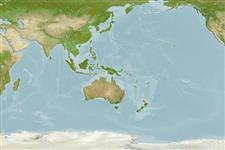Environment: milieu / climate zone / depth range / distribution range
Ökologie
seewasser; brackwasser riff-verbunden; tiefenbereich 1 - 30 m (Ref. 34095). Subtropical; 25°S - 38°S
Western Pacific: Queensland to Victoria, Australia.
Size / Gewicht / Alter
Maturity: Lm ? range ? - ? cm
Max length : 15.0 cm TL Männchen/unbestimmt; (Ref. 4690)
Rückenflossenstacheln (insgesamt) : 15 - 16; Rückenflossenweichstrahlen (insgesamt) : 7 - 9; Afterflossenstacheln: 3; Afterflossenweichstrahlen: 5; Wirbelzahl: 26 - 27. Presence of a large horizontal spine below the eye, a dorsal fin which originates just behind the posterior edge of the eye, and venomous dorsal spines.
Found in seagrass beds in estuaries (extremely common during reproductive season in the austral Spring) and coastal bays, and sponge gardens on inshore reefs. Venomous dorsal spines often inflict a painful sting to fishers (Ref. 34095, 39597). Of no commercial importance but often entrapped in fishing gears such as trawls and can be dangerous to fishermen who attempt to remove these (Ref. 39597).
Life cycle and mating behavior
Geschlechtsreife | Fortpflanzung | Ablaichen | Eier | Fecundity | Larven
Paxton, J.R., D.F. Hoese, G.R. Allen and J.E. Hanley, 1989. Pisces. Petromyzontidae to Carangidae. Zoological Catalogue of Australia, Vol. 7. Australian Government Publishing Service, Canberra, 665 p. (Ref. 7300)
IUCN Rote Liste Status (Ref. 130435: Version 2024-1)
Nutzung durch Menschen
Tools
Zusatzinformationen
Download XML
Internet Quellen
Estimates based on models
Preferred temperature (Ref.
123201): 17.6 - 24.2, mean 20.7 °C (based on 105 cells).
Phylogenetic diversity index (Ref.
82804): PD
50 = 0.6250 [Uniqueness, from 0.5 = low to 2.0 = high].
Bayesian length-weight: a=0.01122 (0.00514 - 0.02450), b=3.04 (2.87 - 3.21), in cm total length, based on all LWR estimates for this body shape (Ref.
93245).
Trophic level (Ref.
69278): 3.2 ±0.3 se; based on size and trophs of closest relatives
Widerstandsfähigkeit (Ref.
120179): mittel, Verdopplung der Population dauert 1,4 - 4,4 Jahre. (Preliminary K or Fecundity.).
Fishing Vulnerability (Ref.
59153): Low vulnerability (10 of 100).
Nutrients (Ref.
124155): Calcium = 51.7 [17.2, 144.7] mg/100g; Iron = 0.661 [0.315, 1.457] mg/100g; Protein = 18.7 [17.1, 20.2] %; Omega3 = 0.348 [0.142, 0.957] g/100g; Selenium = 10.4 [4.3, 25.7] μg/100g; VitaminA = 104 [31, 354] μg/100g; Zinc = 1.37 [0.86, 2.17] mg/100g (wet weight);
